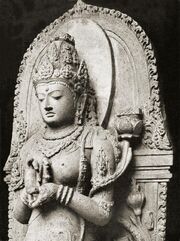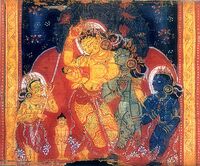Assessment |
Biopsychology |
Comparative |
Cognitive |
Developmental |
Language |
Individual differences |
Personality |
Philosophy |
Social |
Methods |
Statistics |
Clinical |
Educational |
Industrial |
Professional items |
World psychology |
World Psychology: Psychology by Country · Psychology of Displaced Persons

The statue of Prajñāpāramitā the Goddess of transcendental wisdom from Singhasari, East Java.
"Perfection of Wisdom" is a translation of the Sanskrit term prajñā pāramitā (Devanagari: प्रज्ञा पारमिता, Chinese: 般若波羅蜜多/般若波罗蜜多, Pinyin: bōrě-bōluómìduō, Japanese: hannya-haramita Vietnamese Bát Nhã Ba La Mật Đa), which is one of the aspects of a bodhisattva's personality called the paramitas.
The Perfection of Wisdom Sutras or Prajñāpāramitā Sutras are a genre of Mahayana Buddhist scriptures dealing with the subject of the Perfection of Wisdom. The term Prajñāpāramitā alone never refers to a specific text, but always to the class of literature.
History[]
The earliest sutra in this class is the Aṣṭasāhasrikā Prajñāpāramitā Sūtra or "Perfection of Wisdom in 8,000 Lines", which was probably put in writing about 100 BCE and is one of the earliest Mahayana sutras. More material was gradually compiled over the next two centuries. As well as the sutra itself, there is a summary in verse, the Ratnaguṇasaṁcaya Gāthā, which some believe to be slightly older because it is not written in standard literary Sanskrit.

Nativity Scene, Bihar, India, ca. 1150. Prajnaparamita manuscript folio, detail. Opaque watercolor on palm leaf, H2.5 in. (6.35 cm). Los Angeles County Museum of Art, From the Nasli and Alice Heeramaneck Collection, Mu-seum Associates Purchase, M72.1.23. Mayadevi, giving birth in the sacred grove, is supported by the tree goddess (the green figure) as the infant emerges effirtlessly from her side.
Between the years 100 and 300 this text was expanded into large versions in 10,000, 18,000, 25,000 and 100,000 lines, collectively known at the "Large Perfection of Wisdom". These differ mainly in the extent to which the many lists are either abbreviated or written out in full; the rest of the text is mostly unchanged between the different versions. Since the large versions proved to be unwieldy they were later summarized into shorter versions, produced from 300 to 500. The shorter versions include the Heart Sutra (Prajñāpāramitā Hṛdaya Sūtra) and the Diamond Sutra (Prajñāpāramitā Vajracchedikā Sūtra). These two are widely popular and have had a great influence on the development of Mahayana Buddhism. Tantric versions of the Prajnaparamita literature were produced from 500 on.
Teachings[]
The following is a quotation used with permission.
"At first sight, The Perfection of Wisdom is bewildering, full of paradox and apparent irrationality. Yet once one accepts that trying to unravel these texts without experiencing the intuitions behind them is not satisfactory, it becomes clear that paradox and irrationality are the only means of conveying to the reader those underlying intuitions that would otherwise be impossible to express. Edward Conze succinctly summarized what The Perfection of Wisdom is about, saying, 'The thousands of lines of the Prajñāparamitā can be summed up in the following two sentences:
- One should become a bodhisattva (or, Buddha-to-be), i.e. one who is content with nothing less than all-knowledge attained through the perfection of wisdom for the sake of all beings.
- There is no such thing as a bodhisattva, or as all-knowledge, or as a 'being', or as the perfection of wisdom, or as an attainment. To accept both of these contradictory facts is to be perfect.'
The central idea of The Perfection of Wisdom is complete release from the world of existence. The Perfection of Wisdom goes beyond earlier Buddhist teaching that focused on the rise and fall of phenomena to state that there is no such rise and fall — because all phenomena are essentially void. The earlier perception had been that reality is composed of a multiplicity of things. The Perfection of Wisdom states that there is no multiplicity: all is one. Even existence (samsara) and nirvana are essentially the same, and both are ultimately void. The view of The Perfection of Wisdom is that words and analysis have a practical application in that they are necessary for us to function in this world but, ultimately, nothing can be predicated about anything.
Within this context of voidness, The Perfection of Wisdom offers a way to enlightenment. It represents the formal introduction to Buddhist thought of a practical ideal — the ideal of a bodhisattva. Unlike an arhat or pratyekabuddha, beings who achieve enlightenment but cannot pass on the means of enlightenment to others, a bodhisattva should and does teach. A bodhisattva must practice the six perfections: giving, morality, patience, vigour, contemplation and wisdom. Wisdom is the most important of these because it dispels the darkness of sensory delusion and allows things to be seen as they really are."
--R.C. Jamieson : The Perfection of Wisdom (New York : Penguin Viking, 2000. ISBN 0-670-88934-2 pp. 8–9)
For example, the Diamond Sutra concludes with:
As stars, a fault of vision, a lamp,
A mock show, dew drops, or a bubble,
A dream, a lightning flash, or a cloud,
So should one view what is conditioned.
Stars cannot be grasped. Things seen with faulty vision do not really exist. Lamps only burn as long as they have fuel. A mock show is a magical illusion; it is not as it seems. Dew drops evaporate quickly in the heat of the sun. Bubbles are short lived and have no real substance to them. Dreams are not real, even though they may seem so at the time. Lightning is short lived and quickly over. Clouds are always changing shape. By realising the transient nature of things it is easier to detach from them and to attain Nirvana.
Nagarjuna's philosophical explorations of śūnyatā may be derived in part from the Prajñāparamitā literature.
Selected English translations of Perfection of Wisdom sutras[]
| Author | Title | Publisher | Notes |
|---|---|---|---|
| Edward Conze | The Perfection of Wisdom in Eight Thousand Lines and its Verse Summary ISBN 81-7030-405-9 | Four Seasons Foundation | The earliest text in a strict translation |
| Lex Hixon | Mother of the Buddhas: Meditation on the Prajnaparamita Sutra ISBN 0-8356-0689-9 | Quest | A less strict interpretive translation of most of the version in 8,000 lines |
| Edward Conze | The Large Sutra on Perfect Wisdom ISBN 0-520-05321-4 | University of California | Mostly the version in 25,000 lines, with some parts from the versions in 100,000 and 18,000 lines |
| Edward Conze | Buddhist Wisdom Books ISBN 0-04-440259-7 | Unwin | The Heart Sutra and the Diamond Sutra with commentaries |
| Lopez, Donald S. [1] | The Heart Sutra Explained ISBN 0-88706-590-2 | SUNY | The Heart Sutra with a summary of Indian commentaries |
| Lopez, Donald S. [2] | Elaborations on Emptiness ISBN 0-691-00188-X | Princeton | The Heart Sutra with eight complete Indian and Tibetan commentaries |
| Rabten, Geshe [3] | Echoes of Voidness ISBN 0-86171-010-X | Wisdom | Includes the Heart Sutra with a Tibetan commentary |
| Geshe Kelsang Gyatso [4] | Heart of Wisdom ISBN 0-948006-77-3 | Tharpa | The Heart Sutra with a Tibetan commentary |
| Thich Nhat Hanh | The Heart of Understanding ISBN 0-938077-11-2 | Parallax Press | The Heart Sutra with a Ch'an commentary |
| Thich Nhat Hanh | The Diamond that Cuts Through Illusion ISBN 0-938077-51-1 | Parallax Press | The Diamond Sutra with a Ch'an commentary |
| Edward Conze | Perfect Wisdom; The Short Prajnaparamita Texts ISBN 0-946672-28-8 | Buddhist Publishing Group, Totnes. (Luzac reprint) | Most of the short sutras: Perfection of Wisdom in 500 Lines, 700 lines, The Heart Sutra and The Diamond Sutra, one word, plus some Tantric sutras, all without commentaries. |
| Edward Conze | Selected Sayings from the Perfection of Wisdom | Buddhist Society, London | Portions of various Perfection of Wisdom sutras |
External links[]
- Ekashari Prajnaparamita Sutra (English translation)
- Astasahasrika Prajnaparamita Sutra & Ratnagunasamcayagatha (English translation)
- The Prajnaparamita Literature Bibliography of the Prajnaparamita Literature
- Lotsawa House Translations of several Tibetan texts on the Prajnaparamita
See also[]
- Mahayana Sutras
- Diamond Sutra
- Heart Sutra
| This page uses Creative Commons Licensed content from Wikipedia (view authors). |
